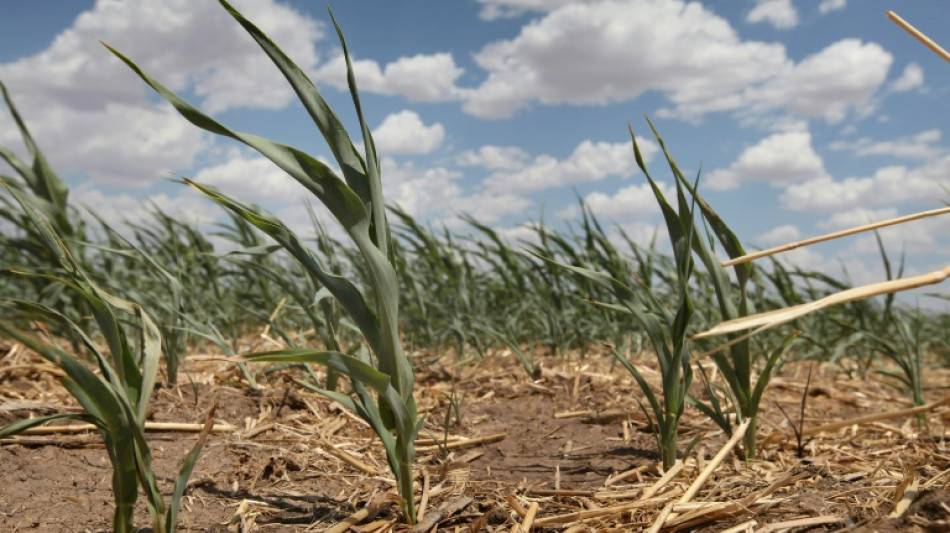
-
 Turkey, Muslim allies say Palestinian self-rule key to Gaza future
Turkey, Muslim allies say Palestinian self-rule key to Gaza future
-
Tens of thousands shelter as typhoon slams into Philippines

-
 Stock markets rise as tech sector buoyed by fresh AI deal
Stock markets rise as tech sector buoyed by fresh AI deal
-
Vitinha says PSG-Bayern Champions League clash will show who's 'best'

-
 Arsenal: The unstoppable Premier League force?
Arsenal: The unstoppable Premier League force?
-
Denmark inaugurates rare low-carbon hydrogen plant

-
 Springboks back Ntlabakanye call-up despite doping probe
Springboks back Ntlabakanye call-up despite doping probe
-
German plans to lower industrial power costs from January

-
 Christian, Muslim Nigerians push back on threatened US strikes
Christian, Muslim Nigerians push back on threatened US strikes
-
Nigeria's Rivers United paired with African champions Pyramids

-
 India women cricketers hail new era but challenges remain
India women cricketers hail new era but challenges remain
-
'Heroic' worker praised as man charged over UK train stabbings

-
 Bangladesh ex-PM Zia to contest elections: party
Bangladesh ex-PM Zia to contest elections: party
-
Tanzania president sworn in as opposition says hundreds killed in protests

-
 India announces $5.75 million reward for women cricket World Cup winners
India announces $5.75 million reward for women cricket World Cup winners
-
Stock markets rise on AI optimism

-
 Spain regional leader resigns, a year after deadly floods
Spain regional leader resigns, a year after deadly floods
-
Video game creators fear AI could grab the controller

-
 France threatens Shein ban if 'childlike' sex dolls reappear
France threatens Shein ban if 'childlike' sex dolls reappear
-
International cricket returns to Faisalabad with Pakistan-South Africa ODIs

-
 Afghan govt says quake kills 20, injures over 500
Afghan govt says quake kills 20, injures over 500
-
'We're all too rich,' says photo legend Martin Parr

-
 Tanzania president inaugurated as opposition says hundreds dead
Tanzania president inaugurated as opposition says hundreds dead
-
Shafali Verma: India's World Cup hero who disguised herself as boy

-
 Most equity markets rise on lingering trader optimism
Most equity markets rise on lingering trader optimism
-
Asian markets rise on lingering trader optimism

-
 Afghanistan quake kills 20, injures over 300: health ministry
Afghanistan quake kills 20, injures over 300: health ministry
-
India hails maiden women's World Cup cricket title as game-changer

-
 As clock ticks down, Greece tries to clean up its act on waste
As clock ticks down, Greece tries to clean up its act on waste
-
Local fabrics, fibres shine at eco-centred Lagos Fashion Week

-
 Spalletti bidding to revive Juve and reputation ahead of Sporting visit in Champions League
Spalletti bidding to revive Juve and reputation ahead of Sporting visit in Champions League
-
Tanzania president to be inaugurated as opposition says hundreds dead

-
 Bouanga brace as LAFC beats Austin 4-1 to advance in MLS Cup playoffs
Bouanga brace as LAFC beats Austin 4-1 to advance in MLS Cup playoffs
-
'Golden age': Japan hails Yamamoto, Ohtani after Dodgers triumph

-
 Thunder roll over Pelicans to remain NBA's lone unbeaten team
Thunder roll over Pelicans to remain NBA's lone unbeaten team
-
Hong Kong legislature now an 'echo chamber', four years after shake-up

-
 Most Asian markets rise on lingering trader optimism
Most Asian markets rise on lingering trader optimism
-
Andrew to lose his last military rank: defence minister

-
 Trump's global tariffs to face challenge before Supreme Court
Trump's global tariffs to face challenge before Supreme Court
-
Barnstorming Bayern face acid test at reigning champions PSG

-
 Alonso shaping new Real Madrid on Liverpool return
Alonso shaping new Real Madrid on Liverpool return
-
Half Yours favourite at Australia's 'race that stops a nation'

-
 Tonga rugby league star has surgery after 'seizure' against NZ
Tonga rugby league star has surgery after 'seizure' against NZ
-
Trent's return with Real Madrid reminds Liverpool of what they are missing

-
 Tehran toy museum brings old childhood memories to life
Tehran toy museum brings old childhood memories to life
-
Iran banking on Iraq vote to retain regional influence

-
 Daughter of 'underground' pastor urges China for his release
Daughter of 'underground' pastor urges China for his release
-
Trump the Great? President steps up power moves

-
 Fire ravages French monastery dubbed 'Notre-Dame of the Ardennes'
Fire ravages French monastery dubbed 'Notre-Dame of the Ardennes'
-
Bills outlast Chiefs while NFL-best Colts fall to Steelers

| CMSD | -0.66% | 23.833 | $ | |
| SCS | 0.31% | 16.01 | $ | |
| JRI | -0.72% | 13.8 | $ | |
| BCE | -1.92% | 22.43 | $ | |
| NGG | -0.66% | 74.757 | $ | |
| RIO | -1.82% | 70.46 | $ | |
| CMSC | -0.25% | 23.69 | $ | |
| RBGPF | -3.95% | 76 | $ | |
| BTI | 2.72% | 52.62 | $ | |
| GSK | -1.15% | 46.325 | $ | |
| RYCEF | 1.24% | 15.34 | $ | |
| AZN | -1.37% | 81.29 | $ | |
| VOD | -5.06% | 11.47 | $ | |
| RELX | -0.51% | 44.015 | $ | |
| BP | 0.24% | 35.215 | $ | |
| BCC | -1.95% | 69.14 | $ |

'Extreme healt belt' to cover middle of US by 2053: report
An area of intensely warm weather -- a so-called "extreme heat belt" -- with at least one day per year in which the heat index hits 125 Fahrenheit (52C), is expected to cover a US region home to more than 100 million people by the year 2053, according to a new study.
The research, carried out by nonprofit First Street Foundation, used a peer-reviewed model built with public and third-party data to estimate heat risk at what they called a "hyper-local" scale of 30 square meters.
First Street Foundation's mission is to make climate risk modeling accessible to the public, government and industry representatives, such as real estate investors and insurers.
A key finding from the study was that heat exceeding the threshold of the National Weather Service's highest category -- called "Extreme Danger," or above 125F -- was expected to impact 8.1 million people in 2023 and grow to 107 million people in 2053, a 13-fold increase.
This would encompass a geographic region stretching from northern Texas and Louisiana to Illinois, Indiana, and Wisconsin -- inland areas far from the more temperate weather often seen near the coasts.
Heat index, also known as the apparent temperature, is what the outside temperature really feels like to the human body when relative humidity is combined with air temperature.
To create their model, the research team examined satellite-derived land surface temperatures and air temperatures between 2014 and 2020, to help understand the exact relationship between the two measurements.
This information was further studied by factoring in elevation, how water is absorbed in the area, the distance to surface water and the distance to a coast.
The model was then scaled to future climate conditions, using a "middle of the road" scenario envisaged by the Intergovernmental Panel on Climate Change, in which carbon dioxide levels start falling by mid-century, but do not reach net zero by 2100.
Beyond "Extreme Danger" days, areas across the whole country are expected to experience hotter temperatures, with varying degrees of resilience.
"These increases in local temperatures result in significant implications for communities that are not acclimated to warmer weather relative to their normal climate," the report said.
For example, a 10 percent temperature increase in the northeastern state of Maine may be as dangerous as a 10 percent increase in the southwestern state of Texas, despite the higher absolute temperatures seen in Texas.
The biggest predicted shift in local temperature occurred in Miami-Dade County, Florida, which currently sees seven days per year at its hottest temperature of 103 Fahrenheit. By 2053, that number is expected to increase to 34 days at 103 degrees.
And the increase in air conditioning use that is likely to result from such temperature spikes will strain energy grids, the report warned, leading to more frequent, longer lasting brownouts.
Y.Zaher--SF-PST
